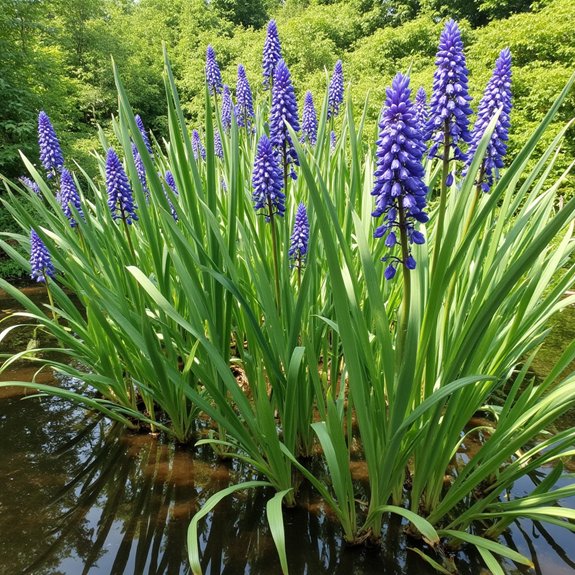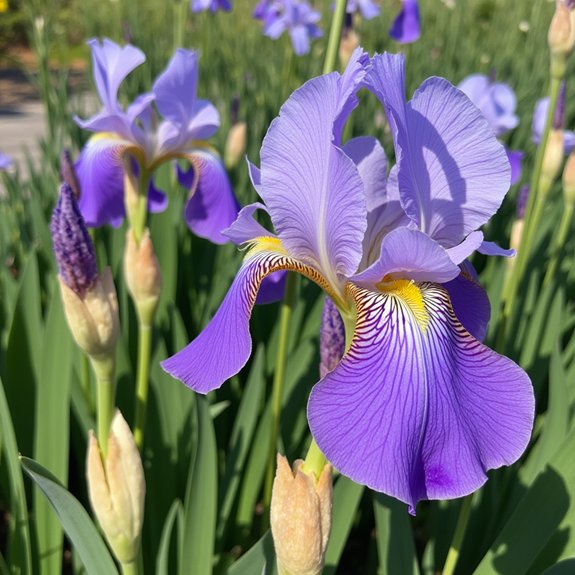Southern Blue Flags transform ordinary gardens into stunning wetland showcases, but success depends entirely on understanding their unique requirements. These native iris species demand specific moisture levels, precise soil conditions, and careful timing for propagation. Most gardeners fail because they treat them like common perennials, ignoring their marsh origins. The key lies in mimicking their natural habitat while avoiding common mistakes that kill even established plants.
Contents
- 1 Understanding the Beauty and Characteristics of Southern Blue Flags
- 2 Essential Planting and Propagation Techniques
- 3 Optimal Growing Conditions and Care Requirements
- 4 Managing Pests, Diseases, and Maximizing Plant Benefits
- 5 Blooming Patterns and Seasonal Expectations
- 6 Distinguishing Features From Northern Blue Flag Varieties
Understanding the Beauty and Characteristics of Southern Blue Flags

When gardeners search for striking native plants that thrive in challenging wet conditions, Southern Blue Flags (Iris virginica) emerge as exceptional choices. These members of the Iris genus showcase vibrant bluish-purple colorful blooms accented with yellow and white centers, creating eye-catching displays from late spring through summer.
Native to Eastern and Southern coastal U.S. regions, these aquatic plants reach 3 feet tall with violet flowers on sturdy stems. Unlike their Northern counterpart Iris versicolor, Southern Blue Flags prefer warmer climates and tolerate USDA Zones 5-9, making them perfect for bog gardens, rain gardens, and shallow water features.
Essential Planting and Propagation Techniques
Southern Blue Flags offer two primary propagation methods that accommodate different gardening preferences and timelines. Seed propagation requires immediate planting after harvest, with fall sowing ensuring spring emergence. Fresh seeds maintain better viability than stored ones.
Rhizome division proves more reliable for consistent results. Divide established clumps every few years during late summer or early autumn, after flowering concludes. Plant rhizomes in early spring or fall, spacing them approximately two feet apart.
Both methods thrive in consistently moist, nutrient-rich soil with full sun exposure. Water regularly, especially during hot weather periods.
Optimal Growing Conditions and Care Requirements

Most gardeners discover that Iris virginica thrives with surprisingly little intervention once basic environmental needs are met. These hardy perennials demand consistently wet, soggy conditions and can tolerate water depths up to six inches. Soil composition proves vital for success, with nutrient-rich loam or clay soils performing best at slightly acidic to neutral pH levels. Regular compost additions boost growth considerably. Sunlight exposure requirements include full sun for best flowering, though afternoon shade benefits plants in extremely hot climates. USDA Zones 5-9 provide ideal growing conditions. Regular watering becomes essential in garden beds, particularly during scorching summer days when moisture evaporates quickly.
Managing Pests, Diseases, and Maximizing Plant Benefits
Beyond establishing proper growing conditions, Virginia Iris presents gardeners with remarkably few challenges regarding pests and diseases. These hardy perennials demonstrate exceptional resistance to common garden problems, including deer browsing, making pest prevention largely unnecessary.
The primary concern involves iris borers, which occasionally target leaves and rhizomes. Regular leaf inspection during growing season enables early detection and swift intervention. Disease management proves minimal due to the plant’s natural resilience.
Beyond ornamental value, Southern Blue Flags attract beneficial pollinators like bees and butterflies while thriving in waterlogged areas where other plants struggle, maximizing garden diversity and ecological benefits.
Blooming Patterns and Seasonal Expectations

When do these striking wetland perennials reach their peak display? Southern Blue Flags deliver their spectacular show from late spring through summer, offering extended blooming frequency that keeps gardens colorful for months. The violet flowers emerge on impressive 3-foot stems, creating dramatic vertical interest in waterlogged areas.
These hardy perennials produce seasonal colors that intensify in full sun conditions. Each bloom features distinctive bluish-purple petals with contrasting yellow and white centers, attracting pollinators throughout the flowering period. Once established, gardeners can expect reliable yearly displays with minimal intervention, making these native beauties dependable performers in challenging wet locations.
Distinguishing Features From Northern Blue Flag Varieties
Geography plays the primary role in separating these two closely related iris species, though several key characteristics help gardeners identify which variety grows in their region. Southern Blue Flag (Iris virginica) displays subtle color variations with deeper violet-purple blooms, while Northern Blue Flag (Iris versicolor) shows lighter blue-purple flowers.
Both species share identical habitat preferences, thriving in wetland conditions and boggy soils. The critical difference lies in cold tolerance. Southern varieties flourish in USDA Zones 5-9, whereas Northern Blue Flags withstand harsher winters in zones 3-7, making climate the determining factor for successful cultivation.
